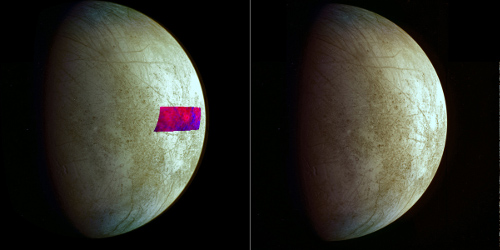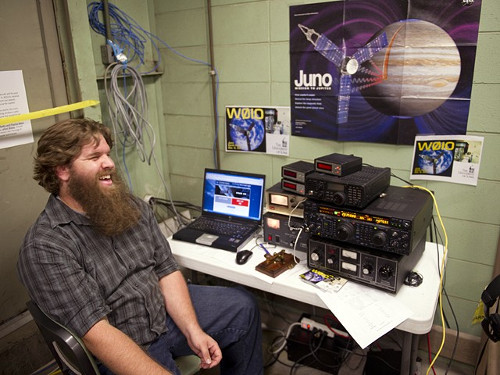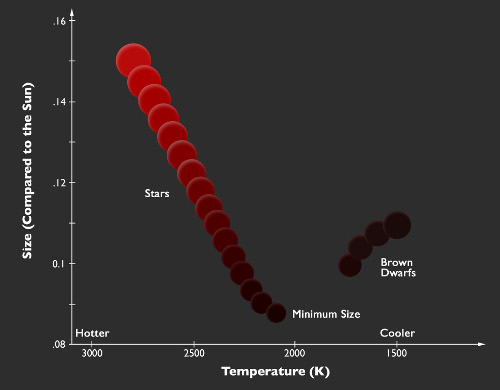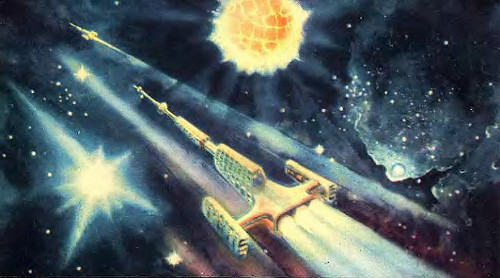Centauri Dreams
Imagining and Planning Interstellar Exploration
Vessel: A Science Fiction Prototype
Futurist and librarian Heath Rezabek returns with further thoughts on preserving mankind’s heritage through Vessels that would contain everything we are as a species. But in an unusual offering, he goes on to provide a fictional look at how such Vessels affect the future. Just how do we preserve and present Earth’s cultural and biological heritage against events we cannot predict? And if we succeed, what shape will our Vessels take, and who will find them? Join Heath as he ventures into ‘science fiction prototyping’ as a way of influencing outcomes.
by Heath Rezabek

I’ve described The Vessel Project in three prior posts:
August 29, 2013 – Deep Time: The Nature of Existential Risk
October 3, 2013 – Visualizing Vessel
November 7, 2013 – Towards a Vessel Pattern Language
Each month I’ll try to do a new A/B sorting survey on the topic of very long term preservation. Past Poll: “Which positioning / placement of a Vessel archive or haven would take priority?” is continually open for refining votes. (http://www.allourideas.org/vessel-positioning-2013)
Current top three: 1st “Tranquility Base (Moon)”, 2nd “Lunar South Pole”, 3rd “Co-located with the 10,000 year clock (Long Now Foundation)”
This month’s new A/B Sorting Survey is:
Which works depicting cultural, biological, or scientific archival / remembrance / recovery would you recognize as exemplars of their kind? (Books, movie, or any other medium. Please add more…)
(http://www.allourideas.org/precursor-works)
– – –
It is my hope that the ideas explored in this series and in my work will help to inspire others with greater means to make these approaches into realities, as it is truly impossible to undertake such large-scale projects alone. Very long term archival and knowledge preservation seems to me a key step on the path towards an eventual interstellar civilization, and the more we explore all aspects of this journey, the greater our chances of collectively making it.
What can’t be clearly imagined can hardly be achieved. When it comes to creating artifacts that might influence or inspire others, the direct route need not be the only one. Methods such as art and fiction, in particular, can be very powerful in the effort to blaze trails towards possible futures. In this regard, one recent development of great interest to me is that of Design Fiction (sometimes also called Science-Fiction Prototyping).
Design Fiction, briefly discussed in the October 3 entry, can be described as fiction whose primary goal is to paint a picture of the possible, without too much concern for filling in all the details beyond the elements being suggested or explored. Science fiction as a speed-sketch: The goal is to strike sparks, since even small sparks can light the wayfinding torches of others — can inspire and motivate through suspension of disbelief. A recent essay on Design Fiction is useful reading. Bruce Sterling’s “Patently untrue: fleshy defibrillators and synchronised baseball are changing the future” in Wired UK is useful reading in coming to terms with this technique of idea exploration.
My Centauri Dreams contribution this month, then, is a brief detour through the realms of the possible, in an original short piece of design fiction.
– – –
Woven Light (I)

Image: Woven Light (Detail) by Heath Rezabek.
Dust, undisturbed for centuries, billowed as it was brushed aside by alloy digits. In darkness this deep, unaided eyes were blind. Yet the sensors attached to these arms soaked up the bare wisps of light and sound in this place, resolving those streams into a coherent model of surrounding space and time.
Deep set into a dais rested a prism, a cubic matrix tilted and sunken halfway into its setting. Recognizing its target, focal beams pierced the vault and the prismatic cube, splitting and refracting as they traced the edges of frozen memory to recover the data there dreaming. For this slow and steady work, long ago Tracer Aakanthia [9T33] had been conceived.
This particular prism was not the only one, but it was part of a set sharing some unique properties. Among them, the fact that light sent through its channels this way would coalesce into myriad forms above and around it, hanging dimensional in space and rotating in time, glowing softly, changing subtly, as the artifacts encoded here resolved and restored their ancient forms.
In the inky black hung an index, a tapestry of woven light, intricate patterns tracing and retracing, spinning outwards and upwards to mark the collections they mapped. Aakanthia scanned back and forth, both reading and rendering as a holographic memory of New York City (circa 2023) replayed. Compression had eroded some of its infinite edges, but fractal resuggestion was a venerable technique for good reason.
There, suspended like smoke in a sunbeam, unfurled countless moments and relations, each endlessly combining and rejoining. The tracer watched and waited, seeking at the speed of split light for the moment it had triangulated as embedded here. And finding it, slowed time to pause and hover amidst the assembly there gathered at a research lab, long since gone, which had released in prior days the fleets of tiny surveyors that had gathered the data mapped here.
Now, records had suggested, they were poised to release a second fleet, this one bound to double the resolution encoded up to then. Yet there would be a problem, and the second array would not finish its task before other needs intervened. Here, shivering and frozen forms waited for the story to retell itself once more.
The light blinked, and darkness collapsed around Tracer Aakanthia [9T33], its momentary mission complete. Gently lifting the cubic shard, it hovered and drifted back towards an array of its own, a cellular framework of woven carbon splines leading it fore towards the sail sections, slipstreaming starward…

Image: NYC (Fractal Resuggestion) by Heath Rezabek.
– – –
The first Vessel Haven installation ever founded had not been fancy, or even enduring; but at least it had been built. After spending years as a virtual shadow-box of sprawling possibilities suspended in naught but 3D space, seen by few and appreciated by fewer, it had finally been realized, a sort of an imaginary Epcot Center, as (of all things) a theme camp at the Burning Man festival that year.
From without, its most striking feature had also been among its most mundane — simple structural realities had collided with the Vessel habitat’s mission to determine that its outer form was that of a good ol’ geodesic dome. Though once these had been notorious for leakages, advances had changed that; and in any case, the desert was a fairly rain-free place for a mock-up. Advances in the autonomy and resourcefulness of the Replicator Bot had meant that the caliber of trusswork needed to seal and harden the thing at 500 feet in diameter could be achieved: silicate-sourced and fabbed on site.
Its distant bulk and form had seemed a sort of postcard from 1969, oddly comforting and quaint; yet when the notoriously brutal sandstorm of that year finally came, no small number of adventurers ended up finding shelter within its sturdy scope. Thus at last the basic function and mission of a Vessel archive could be transmitted in part and whole to a critical mass of curious minds.
The camp was run in such a way that the business of a Vessel Haven was acted out in small scenes by a vast cast and crew, interspersed with the sheltering crowd. Here you’d look and see what seemed for all the world like a clear cryogenic chamber filled with Indo-Burmese rainforest biomass, in transit to a holding tank; there you’d spy an engineer, smartly sporting a color-coded labcoat, trekking a blinking cube of clearstone circuitry from one node of the Vessel Lattice to another.
At regular intervals, hexagonal worktables hosted scale models and reconstructions of all sorts of things — from a nanoscaled reconstruction of the circular ruins of ancient Rujm el Hiri, to the proverbial kitchen sink (impossibly recovered from Frank Lloyd Wright’s Imperial Hotel) — yet there was nary a taxonomist in sight.
On the outer edges, aproned Learning Lab educators walked the curious through the finer points of a vast mural depicting the Long Now Time Diagram, augmented and expanded and overlaid with projected animations of culture’s machinations bootstrapped through time.
All came to a point here, embodied in one stunning and forward-facing lightsail, its Benford-inspired beamed design hauling a streamlined Voronoi spaceframe, zooming out and back in time to reveal the long meander of the technologies and biophilic designs which had suggested it, planted firmly on a foundation of architectural advances and accidents, interwoven with wood and stone and precious flowing water to reveal the vast work of nature and biology supporting it, and out still further, silt sliding, plates upheaving, until geology blurred with planetary formation and the furnaces of infinity ignited in reverse like campfires in the night. Of course, these were exhibits that would normally be shown to the young, but here the young at heart were well practiced at standing in.
Among those present at the Long Now holomural when the presenter had moved aside to make way for the transport of an autopallette of interlocking twisty-puzzle prisms was 17 year old Aben Ramer. First generation HexaYurt builder and second generation Jungian Surrealist, Aben had come for the Hex Space, hearing that one of the largest complexes of interlaced HexaYurt structures ever conceived had been trussed together here-in.

Image: Hex Space Blueprint by Heath Rezabek.
And this much was true. The basic module, just over 13 feet across but infinitely variable through subdivision of standard 4×8 panels, had finally been iterated into multistory structures some while back; but Aben had never seen anything like the interlocking Çatalhöyük of honeycombed spaces layered here. Circumambular disorientation fades fast for the hex-saavy, but still he was impressed by the care clearly woven into a pattern language that had clarified living centers, promenades, and sheltering spaces for all sizes and sorts of activity as one slowly spiralled inwards towards the staff-only areas.
It was then that one of the crystaloid twisty puzzles fell from the autopallette as it passed him by, landing at Aben’s feet so obviously that he suspected synchronistic dramaturgy. Picking it up, he shook his head at this six-edged mirage, thinking he’d got too much hex on the mind. But then a cube resolved as he turned it, and visually slipped again into what seemed like the form of a flattened hexagonal piezoelectric shard.
“What the hell.” But then, before he could move to execute even a single twist of the subshards around which the puzzle had been designed, he thought of his mother.
His mother, he remembered, was at a workshop in New York City. Aben knew well enough — as well as his mother could tell him — that she was at work on a very long term data storage project. (He wondered then whether that connection, too, had brought him to this Vessel in the storm, though he’d swear he hadn’t been conscious of that overlapping theme before he’d arrived.) She couldn’t say as much about the project’s scope or sponsors as she could about some of its requirements.
The team was struggling with the capacities needed for immersive motion holography. She wanted, she’d said, to preserve not just datapoints but dataflows through time. And she wanted to build a seamless bridge that any sentient being could cross, moving (however long it took) from a simple visual understanding that an artifact embodied signal, to the building of the means to decode that signal, and the finding in that signal of ever deeper construction sets leading all the way down to the digital DNA storage technologies that their holography solution had to hug.
Last month they had released a pod of mappers in Central Park, and he knew this week they were there to analyse the results. But the means to store this signal as portably and fluidly as they’d needed had so far eluded them.
He blinked at the apparition, the amusement, in his hands. Tilting it upwards, he beamed a slim vector of light at the puzzle. As he’d expected, he watched it splay through the prism into myriad forms suspended and projected all about. “It’s full of…”
He twisted a shard and beamed it again. Though the patterns had shifted, their subject was clear. Orion’s belt swung gently before his gaze, and then spun. And spinning, dissolved as something else entirely resolved itself anew. He had never seen a white dwarf this closely before; and indeed it was impossible. Yet here it floated, and here he gazed at this impossible diamond adrift in a dome of sky.
He was pretty sure he had found something, at this temporary “here” in the middle of nowhere; a skeleton key for the work his mother was doing.
It would be generations before the Tracer Guild could confirm that Aben’s hunch had been an astronomical understatement.

Image: Beta Vessel by Joshua Davis.

Europa: Minerals from an Ancient Impact?
Europa continues to fascinate those hopeful of finding life elsewhere in our Solar System, and it’s easy to see why. Consider everything the Jovian moon has going for it. Although it’s a long way from the Sun (Jupiter is 5 AU out), Europa gets internal heat from its interactions with the gravitational well around Jupiter, which causes the moon to be stretched and squeezed. We have an ocean whose occasional eruptions into the ice above allow mixing with surface materials and, as this JPL news release points out, salts on the surface that create an energy gradient. These factors have been in place on Europa since the moon first formed.
Now an analysis of data from the Galileo mission has turned up something else needed for life: The likelihood of organic materials. The assumption has been that comet or asteroid impacts could provide these, and the data that Jim Shirley (JPL) will discuss tomorrow at the American Geophysical Union meeting in San Francisco show the presence of clay-type minerals on the moon, assumed to have been delivered by just such a collision. Says Shirley:
“Organic materials, which are important building blocks for life, are often found in comets and primitive asteroids. Finding the rocky residues of this comet crash on Europa’s surface may open up a new chapter in the story of the search for life on Europa.”

Image: This image, using data from NASA’s Galileo mission, shows the first detection of clay-like minerals on the surface of Jupiter’s moon Europa. The clay-like minerals appear in blue in the false-color patch of data from Galileo’s Near-Infrared Mapping Spectrometer. Surfaces richer in water ice appear in red. The background image is a mosaic of images from Galileo’s Solid State Imaging system in the colors that human eyes would see. A version of the image without the infrared area is on the right. Credit: NASA/JPL.
The pattern of the detected minerals gives us some idea about the impactor that brought them. Shirley’s work suggests an asteroid about 1100 meters across or a comet about 1700 meters in size, either of these striking at a shallow angle. The minerals, called phyllosilicates, showed up in near-infrared images from Galileo, appearing as a broken ring about 40 kilometers wide that is 120 kilometers from the center of a central crater site. We’re probably looking at the backsplash of ejected materials from a strike at an angle of about 45 degrees or more off the vertical — a head-on collision would have vaporized the impactor or driven its materials below the surface.
All this assumes, however, that the organic materials did not come from Europa’s interior in the first place. The JPL news release notes that this is unlikely because of the thickness of the icy crust over Europa’s ocean, assumed to be as much as 100 kilometers thick. But the thickness of that crust is still the cause of some controversy, and for that I turn you to Unmasking Europa: Of Ice and Controversy, which looks at Richard Greenberg’s book on the moon and discusses surface features that may indicate a much thinner crust. What we obviously need to make this call is more information, and that may translate into a Europa mission with lander capabilities.

Encounter with a Blue/Green Planet
When I first read about Project Daedalus all those many years ago, I remember the image of a probe passing through a planetary system, in this case the one assumed to be around Barnard’s Star, at high velocity, taking measurements all the way through its brief encounter. And wouldn’t it be a fabulous outcome if something rare happened, like the reception of some kind of radio activity or some other sign of intelligent life on one of the planets there? That thought stayed with me when, much later, I read Greg Matloff and Eugene Mallove’s The Starflight Handbook and began thinking seriously about interstellar flight.
The chance of making such a detection would be all but non-existent if we just chose a destination at random, but by the time we get to actual interstellar spacecraft, we’ll also have an excellent idea — through space- and Earth-based instruments — about what we might find there. These days that ETI detection, while always interesting, isn’t at the top of my list of probabilities, but getting a close-up view of a world with an apparent living environment at whatever stage of evolution would be a stunning outcome. Let’s hope our descendants see such a thing.
Nearby Celestial Encounters
Triggering these musings was a space event much closer to home, the recent passage of the Juno spacecraft, which moved within 560 kilometers of the Earth’s surface on October 9 in a gravity assist maneuver designed to hasten its way to a 2016 encounter with Jupiter. Juno will orbit the giant planet 33 times, studying its northern and southern lights and passing through the vast electrical fields that generate them. I was fascinated to see that the recent close pass marked a milestone of sorts, for the spacecraft detected a shortwave message sent by amateur radio operators on Earth.

Image: Tony Rogers, the president of the University of Iowa ham radio club, mans the equipment used to send a message to the Juno spacecraft in October. The simple message “Hi” was sent repeatedly by ham radio operators around the world. Photos by Tim Schoon.
It’s not a starship picking up an alien civilization’s signals, but Juno did something that previous missions like Galileo and Cassini were unable to do. The latter were able to detect shortwave radio transmissions during their own Earth encounters, but it was not possible to decode intelligent information from the data they acquired. The Waves instrument on Juno, built at the University of Iowa, collected enough data that a simple Morse code message from amateur radio operators could be decoded, leading Bill Kurth, lead investigator for the Waves instrument, to say “We believe this was the first intelligent information to be transmitted to a passing interplanetary space instrument, as simple as the message may seem.”
The Juno team evaluated the Waves instrument data after the October 9 flyby and noted that the message appeared in the data when the spacecraft was still over 37,000 kilometers from Earth. The University of Iowa Amateur Radio Club contacted hundreds of ham stations in 40 states and 17 countries as part of the effort, which was managed through a website and a temporary station set up at the university. Operators from every continent coordinated transmissions carrying the same coded message, with results that can be heard in this video. As public outreach for an ongoing mission, this is prime stuff. Kurth continues:
“This was a way to involve a large number of people—those not usually associated with Juno—in a small portion of the mission. This raises awareness, and we’ve already heard from some that they’ll be motivated to follow the Juno mission through its science phase at Jupiter.”
Also qualifying as excellent public relations is the image below, which came as one of Juno’s sensors offered a low-resolution look at what a fast passage by our planet would be like.

Image: This cosmic pirouette of Earth and our moon was captured by the Juno spacecraft as it flew by Earth on Oct. 9, 2013. Image Credit: NASA/JPL-Caltech.
Scott Bolton, Juno principal investigator, likens the view to a rather famous TV show:
“If Captain Kirk of the USS Enterprise said, ‘Take us home, Scotty,’ this is what the crew would see. In the movie, you ride aboard Juno as it approaches Earth and then soars off into the blackness of space. No previous view of our world has ever captured the heavenly waltz of Earth and moon.”
Getting these images wasn’t easy. The sensors involved, cameras designed to track faint stars, are part of Juno’s Magnetic Field Investigation (MAG) and are normally used to adjust the orientation of the spacecraft’s magnetic sensors. The spacecraft was spinning at 2 rpm during the encounter, so a frame was captured each time the cameras were facing the Earth, with the results processed into video format. Juno now moves on to a Jupiter arrival on July 4 of 2016. If you want to see the Earth flyby with musical accompaniment, see this video and ponder what John Jørgensen (Danish Technical University), who designed the star tracker, says about the event: “Everything we humans are and everything we do is represented in that view.”
Rings a bell, doesn’t it? And why not. This is indeed another of those ‘pale blue dot’ moments.

Brown Dwarfs at the Boundary
We spend a lot of time probing the borderlines of astronomy, wondering what the boundaries are between a large gas giant and a brown dwarf, for example. The other end of that question is also intriguing: When does a true star get small enough to be a brown dwarf? For main sequence stars don’t operate the same way brown dwarfs do. Add hydrogen to a main sequence star and its radius increases. But brown dwarfs work the opposite way, with additional mass causing them to shrink. We see this beginning to happen at the high end of the brown dwarf mass range, somewhere between 60 and 90 Jupiter masses.
Electron degeneracy pressure, which occurs when electrons are compressed into a very small volume, is at play here. No two electrons with the same spin can occupy the same energy state in the same volume — this is the Pauli exclusion principle. When the lowest energy level is filled, added electrons are forced into higher energy states and travel at faster speeds, creating pressure. We see this in other kinds of objects as well. A star of less than four solar masses, for example, having gone through its red giant phase, will collapse and move off the main sequence until its collapse is halted by the pressure of electron degeneracy — a white dwarf is the result.
New work out of the RECONS (Research Consortium on Nearby Stars) group at Georgia State has now found observational evidence that helps us pinpoint the distinction between very low mass stars and brown dwarfs. Let me quote from the preprint to their upcoming paper, slated to appear in The Astronomical Journal, to clarify the electron degeneracy issue:
One of the most remarkable facts about VLM [Very Low Mass] stars is the fact that a small change in mass or metallicity can bring about profound changes to the basic physics of the object’s interior, if the change in mass or metallicity places the object in the realm of the brown dwarfs, on the other side of the hydrogen burning minimum mass limit. If the object is unable to reach thermodynamic equilibrium through sustained nuclear fusion, the object’s collapse will be halted by non-thermal electron degeneracy pressure. The macroscopic properties of (sub)-stellar matter are then ruled by different physics and obey a different equation of state… Once electron degeneracy sets in at the core, the greater gravitational force of a more massive object will cause a larger fraction of the brown dwarf to become degenerate, causing it to have a smaller radius. The mass-radius relation therefore has a pronounced local minimum near the critical mass attained by the most massive brown dwarfs…
With these facts in mind, the RECONS team used data from two southern hemisphere observatories, the SOAR (Southern Observatory for Astrophysical Research) 4.1-m telescope and SMARTS (Small and Moderate Aperture Research Telescope System) in Chile, to take measurements of objects thought to lie at the star/brown dwarf boundary. Says Sergio Dieterich, lead author of the paper:
“In order to distinguish stars from brown dwarfs we measured the light from each object thought to lie close to the stellar/brown dwarf boundary. We also carefully measured the distances to each object. We could then calculate their temperatures and radii using basic physical laws, and found the location of the smallest objects we observed. We see that radius decreases with decreasing temperature, as expected for stars, until we reach a temperature of about 2100K. There we see a gap with no objects, and then the radius starts to increase with decreasing temperature, as we expect for brown dwarfs.”
The diagram below makes the distinction clearer:

Image: The relation between size and temperature at the point where stars end and brown dwarfs begin (based on a figure from the publication). Credit: P. Marenfeld & NOAO/AURA/NSF.
Notice the temperature drop as the size of main sequence stars declines, then the break between true stars and brown dwarfs. The RECONS research indicates that the boundaries can be precisely drawn: Below temperatures of 2100 K, a radius 8.7 percent that of the Sun, and a luminosity of 1/8000th of the Sun, we leave the main sequence. The team identifies the star 2MASS J0513-1403 as an example of the smallest of main sequence stars. Is the gap between true stars and brown dwarfs right after 2MASS J0513-1403 real or is it the effect of an insufficient sample? To find out, the team is planning a larger search to test these initial results.
Note, too, the interesting distinction in the ages of these objects. Small M-dwarfs can live for trillions of years. Brown dwarfs, on the other hand, have much shorter lifetimes, continually fading over time. Whether they could produce a habitable zone over timeframes sufficient to support life is an open question, one that we’ve looked at in Brown Dwarf Planets and Habitability. Our study of small, dim objects and astrobiology is only beginning.
The paper is Dieterich et al., “The Solar Neighborhood XXXII. The Hydrogen Burning Limit,” accepted at the Astronomical Journal and available as a preprint. See this NOAA/SOAR news release for more.

Distant Companions: The Case of HD 106906 b
When the pace of discovery is as fast as it has been in the realm of exoplanet research, we can expect to have our ideas challenged frequently. The latest instance comes in the form of a gas giant known as HD 106906 b, about eleven times as large as Jupiter in a young system whose central star is only about 13 million years old. It’s a world still glowing brightly in the infrared, enough so to be spotted through direct imaging, about which more in a moment. For the real news about HD 106906 b is that it’s in a place our planet formation models can’t easily explain.

Image: This is a discovery image of planet HD 106906 b in thermal infrared light from MagAO/Clio2, processed to remove the bright light from its host star, HD 106906 A. The planet is more than 20 times farther away from its star than Neptune is from our Sun. AU stands for Astronomical Unit, the average distance of the Earth and the Sun. (Image: Vanessa Bailey).
Start with the core accretion model and you immediately run into trouble. Core accretion assumes that the core of a planet like this forms from the accretion of small bodies of ice and rock called planetesimals. The collisions of these objects bulk up the core, which then attracts an outer layer of gas. The problem with applying this model to HD 106906 b is that it’s about 650 AU from its star, far enough out that the core doesn’t have enough time to form before radiation from the hot young star dissipates the already thin gas of the outer protoplanetary disk. Get beyond 30 AU or so and it gets harder and harder to explain how a gas giant forms here.
Gravitational instability is the key to the other major theory of planet formation, but it’s challenged by HD 106906 b as well. Here the instabilities in a dense debris disk cause it to collapse into knots of matter, a process that can theoretically form planets in mere thousands rather than the millions of years demanded by core accretion. But at distances like 650 AU, there shouldn’t be enough material in the outer regions of the protoplanetary disk to allow a gas giant to form.
Grad student Vanessa Bailey (University of Arizona), lead author on the paper presenting this work, describes one of two alternative hypotheses that could explain the planet’s placement:
“A binary star system can be formed when two adjacent clumps of gas collapse more or less independently to form stars, and these stars are close enough to each other to exert a mutual gravitational attraction and bind them together in an orbit. It is possible that in the case of the HD 106906 system the star and planet collapsed independently from clumps of gas, but for some reason the planet’s progenitor clump was starved for material and never grew large enough to ignite and become a star.”
Making this explanation problematic is the fact that the mass ratio of the two stars in a binary system is usually more like 10 to 1 rather than this system’s 100 to 1, but the fact that the remnants of HD 106906’s debris disk are still observable may prove useful in untangling the mystery. A second formation mechanism suggested for planets at this distance from their star is that the planet may have formed elsewhere in the disk and been forced into its current position by gravitational interactions. The preprint notes the problem with this scenario:
Scattering from a formation location within the current disk is unlikely to have occurred without disrupting the disk in the process… We also note that the perturber must be > 11 MJup; we do not detect any such object beyond 35 AU…, disfavoring formation just outside the disk’s current outer edge. While it is possible that the companion is in the process of being ejected on an inclined trajectory from a tight initial orbit, this would require us to observe the system at a special time, which is unlikely. Thus we believe the companion is more likely to have formed in situ in a binary-star-like manner, possibly on an eccentric orbit.
HD 106906 b was found through deliberate targeting of stars with unusual debris disks in the hope of learning more about planet/disk interactions. The team used the Magellan Adaptive Optics system and Clio2 thermal infrared camera mounted on the Magellan telescope in Chile. The Folded-Port InfraRed Echellette (FIRE) spectrograph at Magellan was then used to study the planetary companion. The Magellan data were compared to Hubble Space Telescope data taken eight years earlier to confirm that the planet is indeed moving with the host star.
This unusual gas giant thus joins the small but growing group of widely separated planetary-mass companions and brown dwarf companions that challenge our planet formation models. The massive, ring-like debris disk around HD 106906 helps us constrain the formation possibilities, but we’ll need more data from systems whose disk/planet interactions can be observed before we can speak with any confidence about the origin of these objects.
The paper is Bailey et al., “HD 106906 b: A planetary-mass companion outside a massive debris disk,” accepted at The Astrophysical Journal Letters and available as a preprint. This University of Arizona news release is also useful.

Cosmic Loneliness and Interstellar Travel
Nick Nielsen’s latest invokes the thinking of Carl Sagan, who explored the possibilities of interstellar ramjets traveling at close to the speed of light in the 1960’s. What would the consequences be for the civilization that developed such technologies, and how would such starships affect their thinking about communicating with other intelligent species? Sagan’s speculations took humans not just to the galactic core but to M31, journeys made possible within a human lifetime by time dilation. Nielsen, an author and contributing analyst with strategic consulting firm Wikistrat, ponders how capabilities like that would change our views of culture and identity. Fast forward to the stars, after all, means you can’t go home again.
by Nick Nielsen

In my previous Centauri Dreams post, I discussed some of the possible explanations of what Paul Davies has called the “eerie silence” – the fact that we hear no signs of alien civilizations when we listen for them – in connection with existential risk. Could the eerie silence be a sign that older civilizations than ours have been risk averse to the point of plunging the galaxy into silence, perhaps even silencing others (making use of the Rezabek maneuver)? It is a question worth considering.
For one answer is that we are alone, or very nearly alone, in our galaxy, and probably also in our local cluster of galaxies, and perhaps also alone even in our local supercluster of galaxies. I think this may be the case partly due to the eerie silence when we listen, but also due to what may be called our cosmic loneliness. Not only are our efforts to listen for other intelligences greeted with silence, but also the attempts to demonstrate any alien visitation of our planet or our solar system have turned up nothing. When we listen, we hear only silence, and when we look, we find nothing.
The question, “Are we alone?” has come to take on a scientific poignancy that few other questions hold for us, and we ask this question because of our cosmic loneliness. We are beginning to understand the Copernican revolution not only on an intellectual level, but also on a visceral level, and for many who experience this visceral understanding the result is what psychoanalyst Viktor Frankl called the existential vacuum; the whole cosmos now appears as an existential vacuum devoid of meaning, and that is why we ask, “Are we alone?” We ask the question out of need.

Image credit: TM-1970, Russia (via Dark Roasted Blend).
While talk of alien visitation is usually dominated by discussions of UFOs (and merely by mentioning the theme I risk being dismissed as a crackpot), due to the delay involved in EM spectrum communications, it is at least arguable that communication is less likely than travel and visitation. That being said, I do not find any of the claimed accounts of extraterrestrial visitation to be credible, and I will not discuss them, but I will try to show why visitation is more likely than communication via electromagnetic means.
An organic life form having established an industrial-technological civilization on its homeworld – rational beings that we might think of as peer species – would, like us, have risen from biological deep time, possessing frail and fragile bodies as we do, subject to aging and deterioration. An advanced technological civilization could greatly extend the lives of organic beings, but how long such lives could be extended (without being fully transformed into non-organic beings, i.e., without becoming post-biological) is unknown at present.
For EM spectrum communications across galactic distances, even the most long-lived organic being would be limited in communications to only a small portion of its home galaxy. If civilizations are a rarity within the galaxy, the likelihood of living long enough to engage in even a single exchange is quite low. In fact, we can precisely map the possible sphere of communication of a being with a finite life span within our galaxy (or any given galaxy) based on the longevity of that life form. Even an extraordinarily long-lived and patient ETI would not wish to wait thousands of years between messages, especially in view of the quickening pace of civilization that comes about with the advent of telecommunications.
It could be argued that non-organic life forms take up where organic life forms leave off, and for machines to take over our civilization would mean that length of life becomes much less relevant, but the relative merits and desirability of mechanistic vs. organic bearers of industrial-technological civilization (not to speak of being bearers of consciousness) is a point that needs to be argued separately, so I will not enter into this at present. But whether ETI is biological or post-biological, no advanced intellect is going to send out a signal and wait a thousand years for a response, since in that same thousand year period it would be possible to invent the technologies that would allow for travel to the same object of your communication in a few years’ time (i.e, a few years in terms of elapsed shipboard time).
Our perfect ETI match as a peer civilization in the Milky Way will have already realized that electromagnetic communications mean waiting too long to talk to planetary systems that can be visited directly. If they are a hundred years ahead of us, they may already have started out and may find us soon. If they are a hundred years behind us, they will not yet even have the science to conceive of these possibilities as realizable technological aims. But what is the likelihood, in the universe in which intelligent life is rare (and we know by now that there are no “super-civilizations” nearby us in cosmic terms – cf. my Searching the Sky), that in all the vast space and time of the universe, a peer civilization should arise within a hundred years’ development of our own civilization? Not very likely.
The further we push out the temporal parameters of this observation, the more likely there is another civilization within these temporal parameters, but the further such a civilization is from being a peer civilization. Take a species a thousand years behind us or a thousand years ahead of us: the former cannot form a conception of the universe now known to observational cosmology; the latter will have technological abilities so far beyond ours (having had an industrial-technological civilization that has been in existence five times longer than ours) that we would not be in any sense their peer. And they would have already visited us. If we set the parameters of temporal radius from the present at ten thousand years, or a hundred thousand years, we are much more likely to find life on other worlds, but the further from our present level of development, the less likely any life found would be recognizable as a peer civilization.
How would we visit other worlds directly? With the breakthrough technology of a 1G starship (i.e., a starship than can accelerate or decelerate at a constant of one gravity) [2], all of the waiting to discover the universe and what lies beyond virtually disappears for those willing to make the journey. And while I have called this 1G starship a “breakthrough technology,” it is not likely to happen all at once in a breakthrough, but will probably take decades (if not centuries) of development. Our first interstellar probes, Voyager 1 and Voyager 2, are already headed to the stars [3]. It would take tens of thousands of years for the Voyager probes to arrive at another solar system, should they survive so long. Incremental improvements even in known propulsion technologies will yield gradually more efficient and effective interstellar travel (and will not require any violations of the laws of physics). While we don’t yet have full breakeven in inertial confinement fusion [4], we can in fact achieve inertial confinement fusion at an energy loss, meaning that an inertial confinement fusion starship drive is nearly within the capability of present technology. All of this leaves aside the possibility of breakthrough technologies that would be game-changers (such as the Alcubierre drive).
If we assume that a peer species would emerge from an Earth twin, we can assume that such a peer species would be subject to roughly similar gravitational limitations, so that an ETI 1G starship would be something similar in terms of velocity. Human beings or a peer ETI species, while unable to engage in any but the most limited EM spectrum communications over galactic distances, would find the galaxy opened up to them by a 1G starship, able to explore the farthest reaches of the universe within the ordinary biological lifetime of intelligent life forms even as we know such life forms today (i.e., ourselves), limited to a mere three score and ten, or maybe a bit more.
I have mentioned inertial confinement fusion above as a possible starship propulsion system, but this example is not necessary to my argument. If there existed only a single propulsion proposal for interstellar travel, and all our hopes for such travel rested on an unknown science and an unknown technology, we would have good reason to be skeptical that interstellar travel would ever be possible under any circumstances. This, however, is not the case. There are a wide variety of potential interstellar propulsion technologies, including inertial confinement fusion, matter-antimatter, quantum vacuum thrusters, and other even more exotic ideas. As long as industrial-technological civilization continues its development, some advanced propulsion idea is likely to prove successful, if only marginally so, but marginally will be enough for the first pioneers who are willing to sacrifice all for the chance at a new world.
It is humbling that we know so little about these technologies and the science that underlies them that we are not today in a position to say which among these might prove to be robust and durable drives for a starship, but the very fact that we know so little implies that we have much to learn and we cannot yet exclude any of these exotic starship drive possibilities, much less dismiss them as impossible. While no one has yet produced a proof of concept of any of these proposed forms of propulsion, it is also the case that no one has yet falsified the science upon which they are based.
Even the most successful of the drives mentioned above (with the exception of the Alcubierre drive) will involve time dilation as a condition of interstellar travel. There has been a tendency to view time dilation as a cosmic “fun spoiler” that prevents us seeing the universe on our own terms, since the elapsed time on one’s home world means that no one can return to the world that they left. We need to get beyond this limiting idea and come to see time dilation as a resource that will allow us to travel throughout the galaxy. It is true that time dilation is a limitation, but it is also an opportunity. As Carl Sagan noted:
“Relativity does set limits on what humans can ultimately do. But the universe is not required to be in perfect harmony with human ambition. Special relativity removes from our grasp one way of reaching the stars, the ship that can go faster than light. Tantalizingly, it suggests another and quite unexpected method.” [5]
Human ambition, as Sagan suggests, wants interstellar travel without the price exacted by time dilation, but the universe is not going to accommodate this particular ambition. We have had to reconcile ourselves with the fact that historical transmission is a unidirectional process. We can read Shakespeare, but we cannot talk to Shakespeare. Shakespeare’s contemporary Queen Elizabeth could make it known that she wanted to see Falstaff in love, and “The Merry Wives of Windsor” resulted, but we cannot approach the Bard to write the perfect comedy of manners in which smart phones and text messages figure in the plot.
Just so, we are all unidirectional time travelers, and the eventual development of travel at relativistic velocities will not give us the ability to travel backward in time, nor will it allow us to travel to the stars without giving thought to the inertial frame of reference of our homeworld, but it will give us more alternatives for going forward in time. We will have the opportunity to choose between an inertial framework at rest (presumably relative to our homeworld), and some accelerated inertial framework in which time passes more slowly, allowing us to travel farther and, incidentally, to see more of the universe. Even if we can never go back, we can always go forward. Relativistic interstellar travel will mean that we have a choice as to how rapidly we move forward in time. The possibility of always going farther forward in time has consequences for existential risk mitigation that I will discuss in my next Centauri Dreams post.
Notes
[1] Cf. Viktor Frankl, Man’s Search for Meaning
[2] Carl Sagan discussed the 1G starship in his Cosmos, Chapter VIII, “Travels in Space and Time”; I quote from this same chapter below.
[3] As of this writing, Voyager 1 has passed into interstellar space, while Voyager 2 has not yet emerged from the heliosheath and into interstellar space.
[4] A near breakeven in inertial confinement fusion was recently achieved, in which produced more energy that was absorbed by the fuel for the reaction, but this is not the same as producing as much energy from the fusion reaction as was pumped into the lasers making the reaction happen. (Cf. Nuclear fusion milestone passed at US lab.)
[5] Carl Sagan, Cosmos, Chapter VIII, “Travels in Space and Time” (cf. note [2] above)


